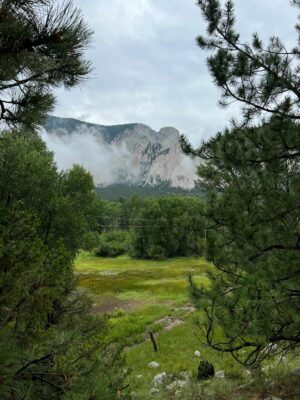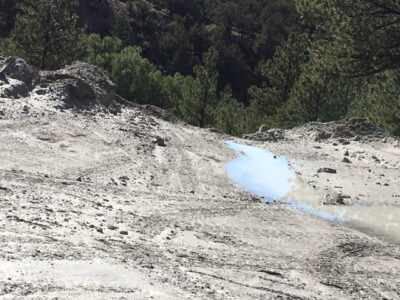It has taken years to get this far, but the fiber infrastructure that is bringing broadband service to Chalk Creek Canyon has made real progress. Given the rugged terrain, and the hurdles of right-of-way, grant funding, and partnership uncertainties, that progress is commendable, although canyon residents remain impatient.
“The Chalk Creek work is continuing. We are already signing up customers on fiber. We started this phase of the work on June 6, and were able to get the first customer lit up on July 13,” said Colorado Central Telecom (CCT) Operations Manager Tonya Wyles. “So far we have three fiber customers installed and have 64 more on the waitlist.”

Colorado Central Telecom is at work on broadband installation in the rugged terrain of Chalk Creek Canyon. Courtesy photo.
The challenge for residents of Chalk Creek Canyon, has been to get information about whether or not their residences are in the path of the fiber improvements. Grant funding has helped add fiber optic lines from the area of Bunny Lane west up the canyon as far as Alpine.
Two years ago, Mt. Princeton Hot Springs got fiber laid along CR 162 from U.S. 285 to the resort. But the latest CCT work still leaves a very important gap; from that intersection of Bunny Lane and CR 162 eastward through residential areas as far as Mt. Princeton Hot Springs.
“That area is not in the area covered by the grant, so we won’t be expanding fiber to that area for at least the next 12 months,” explained Wyles. “We do plan on expanding the fiber path to the east there, but it won’t be until the Chalk Creek grant area is finished, and we get the expansion in the budget.”
Left unsaid is that the area that still doesn’t have grant funding includes the infamous “Dip” where chalky residue from the cliffs grinds down a winding path and crosses the county road. That flowing deluge into the Chalk Creek (giving the creek its name) regularly closes the road a couple of times each summer, and Chaffee County has gotten very efficient at digging it out.
The magnitude of the flow makes the prospect of buried fiber optics somewhat of a challenge, so there, different solutions might need to be developed.

When storms stall over the Chalk Cliffs, the infamous dip, in Chalk Creek Canyon flows with debris that closes CR 162. Photo by Jan Wondra.
CCT is based in Buena Vista Colorado, and serves rural South-Central Colorado. It provides locally-managed broadband and internet access and its service area includes Gunnison, Lake, Chaffee, Fremont, Custer, and Huerfano counties.
Colorado Central Telecom says that it prides itself in providing reliable broadband with small-town customer service. As it slowly expanded its service area, it has faced setbacks but has continued to persevere, perhaps contributing to its strong team environment.
In 2018, it set about obtaining grant funding to install fiber optics in Chalk Creek Canyon, only to face right-of-way hurtles; first with the federal lands of the U.S. Forest Service, then in collaboration with Sangre de Cristo Electric.
The goal, of course, is to provide broadband and wireless cell phone coverage for Chalk Creek Canyon. This is not just a residential area, but a popular tourist recreation area with little communications access.
The absence of fiber optics coverage in the canyon has made it a public safety concern, not just for residents who want reliable internet access, but because of the thousands of tourists recreating in the narrow canyon on any given summer week. Should there be a public safety emergency, there is only one way out of the canyon, and until CCT completes its fiber optics installation, limited communications.
As reported by Ark Valley Voice on Aug. 2, the ownership of CCT has recently changed. The sale of CCT to Chaffee businessman Carlin Walsh was approved by the board on July 18, 2022.
The deployment of broadband has lagged all across the West and in rural areas of the country. While metro areas get the latest 5-G and 6-G connectivity and stream movies, huge gaps have remained in rural areas where mobile phones regularly drop calls or don’t connect at all. For more about the lag and what is being done to address it, follow this link.






Recent Comments